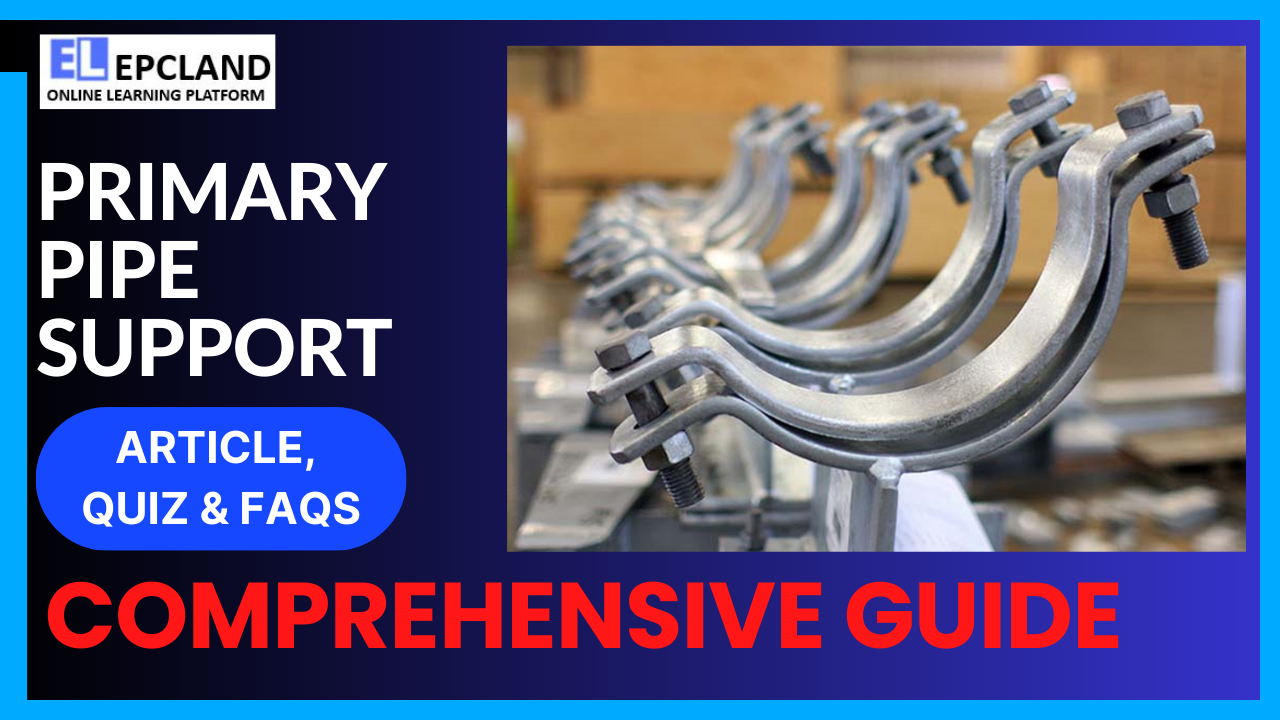I. Introduction
The oil and gas industry relies on a complex network of pipelines to transport fluids and gases across vast distances. To ensure the integrity and reliability of these pipelines, various components and systems are employed. One crucial element in this infrastructure is the primary pipe support system. In this article, we will delve into the world of primary pipe supports, exploring their history, functions, types, applications, advantages, and associated codes and standards.
Table of Contents
Don’t miss the Complete Course on Piping Engineering: Check Now
Enrollment Link
II. Brief History
The use of pipe supports in the oil and gas industry can be traced back to the early days of pipeline development. As pipelines grew in size and complexity, so did the need for efficient support systems. Early supports were often simple structures made of wood or steel. Over time, advancements in materials and engineering led to the development of more sophisticated primary pipe support systems, capable of withstanding the harsh conditions of the oil and gas industry.
III. Basic Function and Working Principle
Function of Primary Pipe Supports
The primary function of pipe supports in the oil and gas industry, including primary pipe supports, can be summarized in a single word: stability. These supports are designed and installed to ensure that pipelines remain stable and secure under various conditions. Here are the key functions they serve:
- Preventing Sagging and Bending: One of the primary functions of primary pipe supports is to prevent pipelines from sagging or bending under their weight or due to external forces. This is crucial because sagging or bending can lead to uneven stress distribution, increasing the risk of structural failure.
- Load Distribution: Primary pipe supports play a vital role in distributing the weight of the pipeline and its contents evenly. By doing so, they prevent localized stress points that could lead to deformations, leaks, or ruptures.
- Absorbing Thermal Expansion and Contraction: In many pipeline systems, temperature variations cause the pipes to expand and contract. Primary supports must be designed to accommodate these thermal changes while maintaining the structural integrity of the pipeline.
- Minimizing Vibration and Movement: Vibrations caused by fluid flow, machinery, or external factors can be detrimental to pipeline integrity. Primary supports help minimize these vibrations and ensure that the pipeline remains stable, reducing the risk of fatigue-related failures.
- Enhancing Safety: Ensuring the stability of pipelines is critical for safety. Unstable pipelines can pose significant risks, including leaks, spills, and accidents. Primary supports contribute to overall safety in the oil and gas industry by preventing these risks.

Working Principle
The working principle of primary pipe supports is rooted in fundamental principles of structural engineering and material science. These supports are meticulously designed to provide a secure and stable foundation for pipelines. The working principle can be broken down into several key components:
- Material Selection: The choice of materials for primary pipe supports is critical. The materials must be capable of withstanding the loads, stresses, and environmental conditions to which they will be exposed. Common materials include steel, stainless steel, and various corrosion-resistant alloys.
- Design Considerations: Engineers use detailed calculations and computer-aided design (CAD) software to determine the optimal size, shape, and configuration of primary pipe supports. These designs take into account factors such as pipe diameter, weight, operating temperature, and the expected loads the supports will bear.
- Load Distribution: Primary supports are strategically placed along the length of the pipeline to distribute the weight evenly. This prevents localized stress concentrations that could weaken the pipeline.
- Flexibility and Movement: In some cases, primary supports need to allow for controlled movement, such as thermal expansion and contraction. In such instances, flexible elements, such as spring hangers or sliding supports, may be incorporated into the design.
- Installation and Maintenance: Proper installation is crucial to ensuring the effectiveness of primary pipe supports. Regular maintenance and inspections are also essential to identify any signs of wear, corrosion, or damage and to address them promptly to maintain support integrity.
- Safety Measures: Safety is a paramount concern in the oil and gas industry. Primary supports are often designed with redundancy and fail-safe mechanisms to ensure that even in the event of a failure, the pipeline remains stable until repairs can be made.
IV. Types of Primary Pipe Supports
Primary pipe supports are essential components of pipeline systems, and they come in different types, each designed to fulfill specific functions and address particular challenges. Here’s a closer look at these various types:
1. Pipe Shoes
Function: Pipe shoes are rigid supports attached to the bottom of the pipe. Their primary function is to prevent vertical movement or sagging of the pipeline.
Design and Features:
- Pipe shoes are often made of strong materials such as steel or composite materials to bear the weight of the pipeline.
- They are designed with a curved or flat surface to cradle the pipe securely.
- Some pipe shoes incorporate anti-friction materials to reduce friction and wear between the pipe and the support.
Applications: Pipe shoes are commonly used in situations where there is a need to provide consistent and stable support to pipelines. They are especially useful in onshore pipelines and industrial settings where vertical movement needs to be restricted.
2. Pipe Guides
Function: Pipe guides are designed to control the lateral movement of pipes while allowing for axial movement. They prevent the pipeline from moving excessively sideways, maintaining its alignment.
Design and Features:
- Pipe guides are typically composed of a channel or groove that securely holds the pipeline.
- They are designed to allow limited lateral movement while guiding the pipe axially.
- Some pipe guides are equipped with rollers or slide plates to further reduce friction during lateral movement.
Applications: Pipe guides are crucial in scenarios where pipelines are subjected to thermal expansion and contraction, such as in refineries and industrial facilities. They help maintain the proper alignment of pipes, reducing stress and potential damage.
3. Pipe Anchors
Function: Pipe anchors provide fixed points of support for pipelines, preventing movement in both axial and lateral directions. They are essential for maintaining pipeline stability.
Design and Features:
- Pipe anchors are designed to resist movement in multiple directions, ensuring the pipeline remains firmly in place.
- They often include multiple anchor points and strong construction materials.
- Some pipe anchors incorporate expansion joints to accommodate thermal expansion.
Applications: Pipe anchors are commonly used in critical areas where the pipeline must remain stationary, such as at bends, junctions, or near equipment like pumps and compressors. They are essential for preventing vibrations and excessive movement.
4. Spring Hangers
Function: Spring hangers use a spring mechanism to support pipelines while allowing for vertical movement. They help absorb shock and vibration, especially in systems with dynamic loads.
Design and Features:
- Spring hangers are equipped with springs or elastomeric elements that provide a cushioning effect.
- They can be adjustable to control the amount of vertical movement allowed.
- Spring hangers are often used in combination with other supports to handle variable loads.
Applications: Spring hangers find applications in environments where pipelines are subjected to dynamic loads, such as in industrial processes and power plants. They help reduce the stress on the pipeline and associated equipment.
5. Constant Supports
Function: Constant supports are designed to maintain a constant load on the pipeline, compensating for variations in weight and temperature. They provide consistent support, reducing stress and strain.
Design and Features:
- Constant supports use mechanisms like counterweights or springs to balance the pipeline load.
- They are engineered to ensure that the load remains constant throughout the pipe’s movement range.
- Some constant supports are equipped with locking mechanisms to prevent unintended adjustments.
Applications: Constant supports are utilized in systems where the weight of the pipeline varies significantly due to changes in temperature, fluid levels, or other factors. They help maintain consistent support, preventing deformation and stress on the pipeline.
Don’t miss the Complete Course on Piping Engineering: Check Now
Enrollment Link
V. Applications of Primary Pipe Supports
Primary pipe supports are essential components in a wide range of applications within the oil and gas industry. Their primary function is to provide stability and structural integrity to pipelines, ensuring that they can withstand the demands of various environments and operational conditions. Here, we explore the specific applications where primary pipe supports are crucial:
1. Onshore Pipelines
Onshore pipelines are used to transport oil, natural gas, and various petroleum products over land, often through diverse terrains and changing elevations. In these applications, primary pipe supports serve several critical purposes:
- Elevation Changes: Onshore pipelines may encounter changes in terrain, including hills, valleys, and slopes. Primary supports help maintain the proper elevation of the pipeline, ensuring efficient fluid flow and preventing excessive stress on the pipes.
- Temperature Variations: Temperature fluctuations can cause pipes to expand and contract. Primary pipe supports are used to accommodate thermal expansion and contraction, preventing structural damage.
- Pipeline Crossings: Onshore pipelines may cross roads, rivers, and other obstacles. Supports are used to secure the pipeline in place during these crossings and maintain the required clearance.
2. Offshore Pipelines
Offshore pipelines are subjected to even more challenging conditions, including exposure to saltwater, strong currents, and harsh weather. Primary pipe supports in offshore applications are specially designed to withstand these conditions:
- Corrosion Resistance: Materials used for primary supports in offshore pipelines are selected for their corrosion resistance to withstand the corrosive effects of seawater.
- Dynamic Loading: Offshore pipelines can experience dynamic loads from waves and currents. Supports must be designed to absorb and distribute these loads to prevent structural damage.
- Subsea Installations: In some cases, pipelines are installed on the seabed. Primary supports secure the pipes to the ocean floor, ensuring stability and preventing displacement due to underwater currents.
3. Petrochemical Plants
Petrochemical plants are complex industrial facilities that process raw materials like crude oil and natural gas into various chemical compounds and petroleum products. Primary pipe supports play a critical role within these plants:
- Safety and Reliability: Ensuring the stability of piping systems within petrochemical plants is vital to prevent leaks or ruptures that could lead to hazardous chemical releases. Primary supports maintain the structural integrity of these systems.
- Maintenance Accessibility: Properly designed supports allow for easy access to pipes for inspection and maintenance, reducing downtime and ensuring operational efficiency.
4. Refineries
Refineries are key components of the oil and gas industry, responsible for processing crude oil into a wide range of products, including gasoline, diesel, and petrochemical feedstocks. Primary pipe supports are used extensively in refineries:
- High Temperature Environments: Refinery processes involve high temperatures and pressures. Primary supports must be designed to handle the thermal expansion and contraction of pipes under these extreme conditions.
- Transport of Various Products: Refineries transport a wide range of products through their piping systems. Primary supports ensure the safe and reliable movement of these products, from raw materials to finished products.
5. Natural Gas Distribution
The distribution of natural gas to homes and businesses relies on an extensive network of pipelines. Primary pipe supports are integral to the safe and efficient operation of these distribution systems:
- Urban Environments: Natural gas pipelines often traverse urban areas, and primary supports help maintain the integrity of the pipelines amidst varying terrain and urban infrastructure.
- Pressure Regulation: In distribution systems, maintaining proper pressure levels is crucial for safety and efficiency. Primary pipe supports are used to secure pressure regulation components and maintain consistent gas flow.
- Safety and Reliability: Ensuring the structural integrity of gas distribution pipelines is paramount to prevent leaks and ensure the safety of the public.
VI. Advantages & Disadvantages
Advantages of Primary Pipe Supports
| Advantages | Explanation |
|---|---|
| Ensures Pipeline Integrity | Prevents sagging, bending, and excessive movement. |
| Extends Pipeline Lifespan | Reduces stress and wear on pipelines, prolonging their life. |
| Enhances Safety | Minimizes the risk of leaks, ruptures, and accidents. |
| Supports Varied Applications | Suitable for onshore, offshore, and industrial settings. |
Disadvantages of Primary Pipe Supports
| Disadvantages | Explanation |
|---|---|
| Initial Installation Costs | Designing and installing primary supports can be expensive. |
| Maintenance Requirements | Regular inspections and maintenance are essential. |
| Design Complexity | Proper design and selection are critical for effectiveness. |
| Environmental Impact | Material selection can impact environmental sustainability. |
VII. Associated Codes & Standards
To ensure the safe and reliable use of primary pipe supports in oil and gas industry projects, adherence to industry-specific codes and standards is essential. Some of the key codes and standards include:
- American Petroleum Institute (API) Standards
- ASME B31.4 and ASME B31.8
- International Organization for Standardization (ISO) Standards
- Pipeline Research Council International (PRCI) Guidelines
Compliance with these standards helps ensure that primary pipe support systems are designed, installed, and maintained to meet industry best practices and safety requirements.
VIII. Conclusion
Primary pipe supports are the unsung heroes of the oil and gas industry, providing vital structural support to pipelines that span vast distances and endure challenging conditions. Understanding their history, functions, types, applications, advantages, and the importance of adhering to industry codes and standards is essential for the successful implementation of oil and gas projects. As the industry continues to evolve, so too will the technology and materials used in primary pipe supports, further enhancing the efficiency and reliability of this critical infrastructure.
In conclusion, primary pipe supports are a linchpin in the oil and gas industry, ensuring the safe and efficient transportation of vital resources while minimizing the risk of costly accidents and environmental damage. Their continued development and improvement will be pivotal in meeting the industry’s growing demands and challenges in the years to come.
FAQs
1. What is the primary function of primary pipe supports in the oil and gas industry?
- Answer: The primary function of primary pipe supports is to anchor and support pipelines, preventing sagging, bending, or excessive movement. They help maintain the integrity of pipelines, ensuring their long-term reliability.
2. What are the main types of primary pipe supports used in the industry?
- Answer: The main types of primary pipe supports include pipe shoes, pipe guides, pipe anchors, spring hangers, and constant supports. Each type serves specific purposes and is selected based on the application and requirements.
3. Why are primary pipe supports crucial in offshore oil and gas pipelines?
- Answer: In offshore pipelines, primary pipe supports are essential because they need to withstand harsh conditions, including the corrosive effects of seawater. These supports ensure the stability and integrity of underwater pipelines.
4. How do primary pipe supports contribute to safety in the oil and gas industry?
- Answer: Primary pipe supports enhance safety by reducing the risk of pipeline leaks, ruptures, and accidents. They help maintain the structural integrity of pipelines, preventing catastrophic failures that can have serious safety implications.
5. What are the key industry codes and standards that govern primary pipe support systems?
- Answer: Some of the key industry codes and standards include those set by the American Petroleum Institute (API), ASME B31.4 and B31.8, International Organization for Standardization (ISO) standards, and guidelines from the Pipeline Research Council International (PRCI). Adhering to these standards ensures the safe and reliable use of primary pipe supports in oil and gas projects.
Recommended courses (Published on EPCLand)
- Basics of Piping Engineering
- Piping Layout Engineering
- Piping Material Engineering
- Piping Stress Analysis
- Complete Course on Piping Engineering
- Material Requisitions
- Piping Material Specifications
- Valve Material Specifications
Don’t miss the published articles on following:
Don’t miss the Complete Course on Piping Engineering: Check Now
Enrollment Link
Attempt Quiz
Question 1:
What is the primary purpose of pipe supports in an Oil & Gas Industry project?
Explanation: Pipe supports in the Oil & Gas Industry provide structural stability to pipelines, ensuring they remain secure and in place.
Question 2:
What are the two main types of primary pipe supports used in Oil & Gas projects?
Explanation: The two main types of primary pipe supports used in Oil & Gas projects are hangers and shoes.
Question 3:
Which type of primary support is used to suspend pipes from overhead structures?
Explanation: Hangers are used to suspend pipes from overhead structures in Oil & Gas projects.
Question 4:
Which type of primary support is used to support pipes resting on the ground or a supporting structure?
Explanation: Shoes are used to support pipes resting on the ground or a supporting structure in Oil & Gas projects.
Question 5:
What is the primary material used in the construction of pipe shoes for high-temperature applications?
Explanation: Inconel is the primary material used in the construction of pipe shoes for high-temperature applications in Oil & Gas projects.
Question 6:
What is the primary function of pipe clamps in the Oil & Gas Industry?
Explanation: Pipe clamps in the Oil & Gas Industry are used to provide support and secure pipes in place.
Question 7:
What is the primary function of pipe anchors in Oil & Gas projects?
Explanation: Pipe anchors in Oil & Gas projects are used to provide stability and prevent the movement of pipes.
Question 8:
Which type of primary support is commonly used in underwater pipeline installations?
Explanation: Anchors are commonly used in underwater pipeline installations as primary pipe supports.
Question 9:
What is the main advantage of using pipe hangers in Oil & Gas projects?
Explanation: The main advantage of using pipe hangers in Oil & Gas projects is that they allow for thermal expansion and contraction of pipes.
Question 10:
What is the purpose of pipe shoes in Oil & Gas projects?
Explanation: Pipe shoes in Oil & Gas projects are used to support and protect pipes from corrosion.



